Shark Species Identification
Introduction
The most infamous predator of the sea, sharks are also a popular quarry for anglers. Not all species of sharks are great targets for fishing – a great white shark may not be something you would want to bring up to your boat – but there are several favorite species for recreational anglers. This section will look more closely at some of the most popular sharks that anglers target.
Shortfin Mako (Bonito) Shark
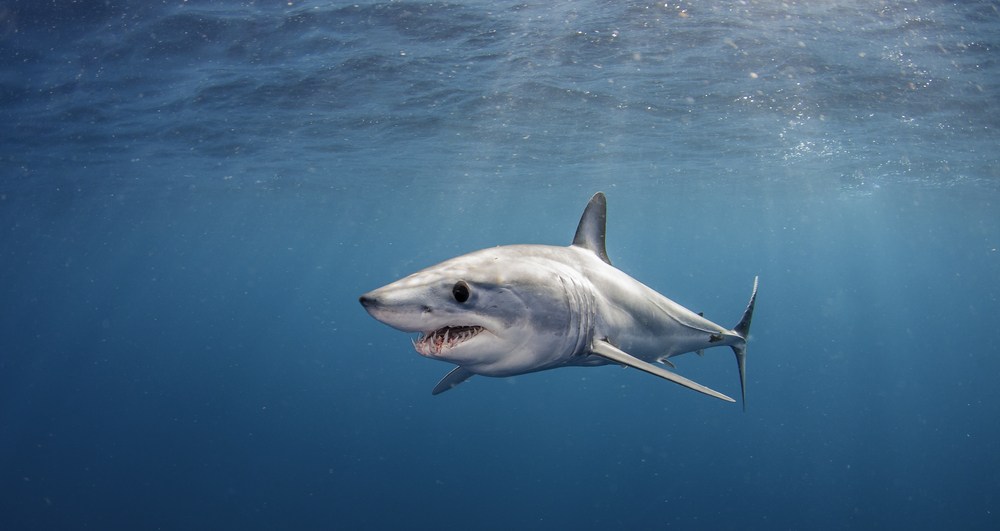
The shortfin mako – or bonito as it is called in the Pacific – is the premier species of choice for shark anglers in North America. They grow big, are terrific fighters, and actually make a good meal as well for those who enjoy eating their catch, though it is advised you release them to help keep the population strong. They are especially prevalent in the western Atlantic, getting the biggest in northeast United States and Canada. Prepare for the fight of your life when catching one: they will unleash all their fury, leaping as high as 30 feet out of the water, and will roll, shake, dive, and even charge the boat. On top of it all, there have even been reports of makos biting boats and leaping into them, causing severe injuries to the angler and wreaking havoc in the cockpit. Fish with caution, and with an experienced team for larger ones.
Appearance
The body of the shortfin mako shark is elongate but rather stout. The snout is long and pointed. The first dorsal and the pectoral fins are large, but the second dorsal and anal fins are very small. This species is a deep blue or dark gray above and white below. There is a black spot at the base of the pectorals.
Maximum Size
Largest ever recorded length of 13 feet (4 m) and can weigh over 1000 pounds (453.6 kg).
Geographic Range
This shark is found worldwide in warm and temperate seas; in the eastern Pacific from Chile to the Columbia River, Washington, including the Gulf of California, but not in the tropics.
Habitat
Shortfin makos prefer open sea environments offshore.
Food
Mackerel, tuna, bonito, porpoises, turtles, other sharks.
Shortfin Mako Shark Fishing Tips
The best way to catch a mako is to troll with whole tuna, mullet, squid, mackerel, or lures. Chumming is also highly effective, used most often in the Atlantic.
World Record
1221 lb 0 oz (Chatham, Massachusetts, 2001)
Thresher Shark
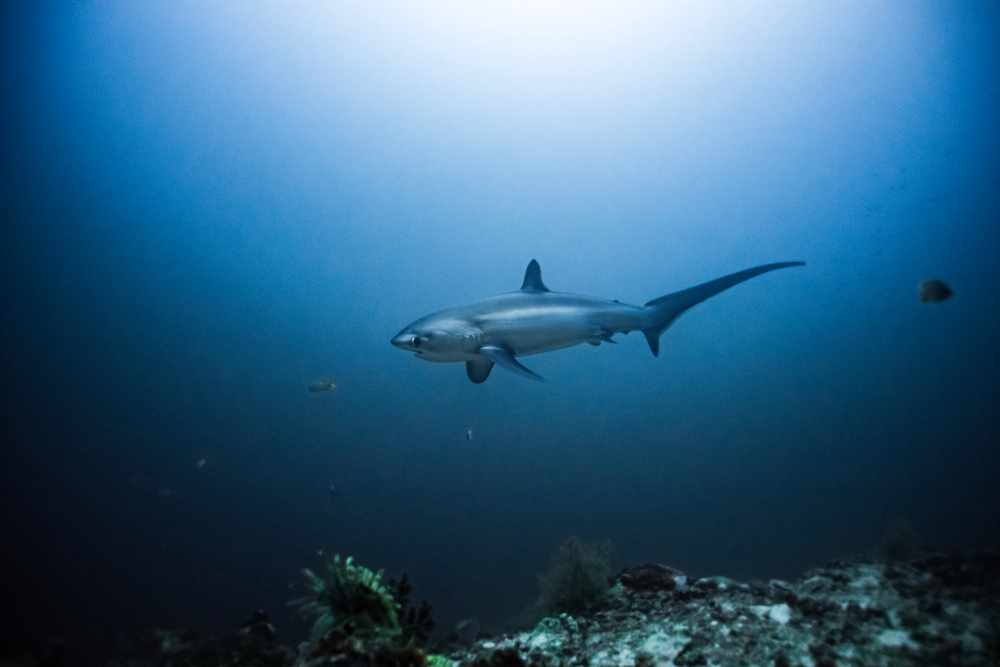
Varying species of thresher sharks are found throughout both the Atlantic and Pacific ocean. They tend to stick to coastal salt waters, but have been known to swim offshore at depths of over 1500 feet. They are generally solitary hunters, though sometimes hunt in pairs when a large school of bait fish is around. Like the shortfin mako, thresher sharks leap out of the water when caught by anglers, especially the longtail thresher.
Appearance
The body of the common thresher shark is moderately elongate. The snout is rather short, and the mouth crescent shaped. The first dorsal fin is large, and located midway between the pectoral and ventral fins. The second dorsal and anal fins are very small. The tail is distinctive since it is very long, almost as long as the rest of the body. The coloration may vary from brownish gray, bluish or blackish above to silvery, bluish or golden below. The dorsal, pectoral and ventral fins are blackish and sometimes the pectoral and ventral fins have a white dot in the lip. The bigeye thresher also occurs off the California coast. It can be distinguished by its large eye; however, if you can count the teeth in the upper jaw, the common thresher has 21-22 on each side while the bigeye thresher has 10 – 11 on each side.
Maximum Size
Largest ever recorded length of 20 feet and weight of 1000 pounds (453.6 kg).
Geographic Range
The common thresher shark occurs worldwide in warmer seas. In the eastern North Pacific, it is found from central Baja California, to the Strait of Juan de Fuca, British Columbia.
Habitat
The common thresher is an inhabitant of the upper layers of deep offshore waters and is most abundant in areas of steep bottom contour along the edges of the continental shelf. During the spring and summer months smaller threshers may occur near shore where they are often seen leaping completely out of the water.
Food
Mostly small fish such as sardines, anchovies, mackerel, and squid.
Thresher Shark Fishing Tips
Trolling is the best way to go as chumming doesn’t prove to be very effective with threshers. Whole baits, strip baits, live yellowtail, snapper, or mullet work well as bait, but you can also use artificial lures and feathers, in the same manner you would for marlins.
World Record
767 lb 3 oz (Bay of Islands, New Zealand, 1983)
Blue Shark
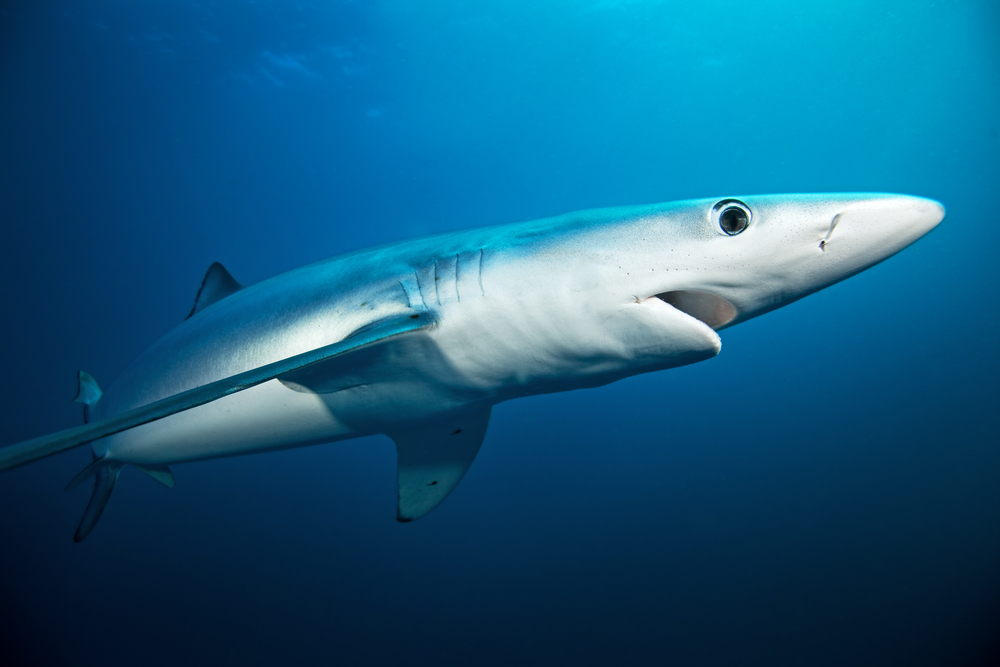
Blue sharks are a favorite target for anglers in North America, primarily because of their large range. They are not the most aggressive of sharks, but still provide a spirited and entertaining fight when caught as they are a very fast swimming fish.
Appearance
These brilliantly colored sharks – deep blue on top, lighter blue on the sides, and white on the underbelly – are unique in that the larger teeth of the upper jaw are “saber shaped,” with serrated edges. Their elongated body is punctuated by extraordinarily long pectoral fins.
Maximum Size
Can grow to over 12 feet long and weigh up to 860 pounds, but they rarely get over 500 lb.
Geographic Range
Blue sharks are often considered of being the most widely distributed animal on the planet. They can be found off the coast of every continent apart from Antarctica, though they are most prevalent in the Mediterranean and the west Atlantic, specifically between New England and Florida.
Habitat
Blue sharks are found in both temperate and tropical areas, but prefer the cooler temperature of deeper water.
Food
Small fish and squid.
Blue Shark Fishing Tips
The best methods for catching blue sharks are chumming with live or dead baits or trolling. Baits include squid, eels, mackerel, herring and other live, whole fishes or cut baits. They do not care for tuna, so avoid using them as bait.
World Record
528 lb 0 oz (Montauk Point, New York , USA, 2001)
Great Hammerhead Shark
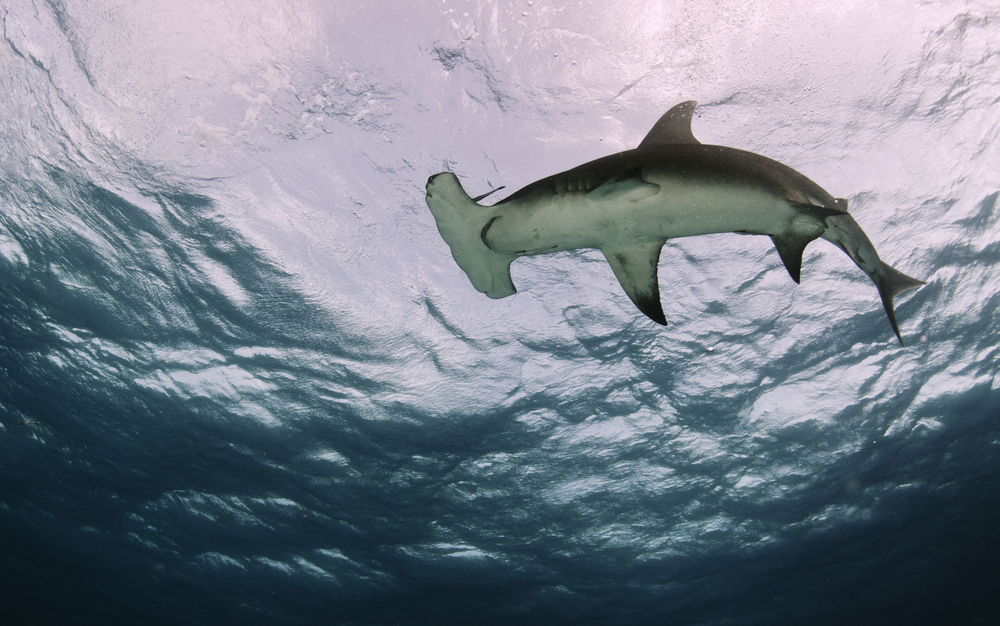
Hammerheads are hard-fighting sharks that thrash about greatly, making long surface and mid-water runs. The great hammerhead, the largest of its kind, make an especially tough fight, using its vast size to try and overpower the angler when caught.
Appearance
These unique looking sharks gets its name from its head, which is t-shaped, with one eye on either side of the twin protrusion. Great hammerheads grow to lengths of 20 feet. They can be distinguished from other hammerheads not only for their size, but also their sickle-shaped dorsal fin and unique tail shape.
Maximum Size
Though there have been great hammerheads known to have grown up to 20 feet in length, they rarely grow longer than 15 feet.
Geographic Range
Tropical waters around the world. They are a migratory fish, and there have been reports of hammerheads moving closer to the poles in the summertime.
Habitat
Great hammerheads may be found at a variety of depths, from inshore waters of less than 4 ft deep, to a depth of 230 ft offshore. They favor coral reefs, but also inhabit continental shelves, island terraces, lagoons, and deep water near land.
Food
Hammerheads search for food hidden beneath the sand, swinging its head back and forth, much like the way we would use a metal detector. Sting rays are a favorite prey, but hammerheads will also eat small fish, striped bass and crustaceans.
Hammerhead Shark Fishing Tips
Slow trolling, drifting or still fishing with chum and baits that are oily or bloody. Mackerel, jack, squid and other baits, as well as artificial lures, may also work on occasion.
World Record
1280 lb 0 oz (Boca Grande, Florida , USA, 2006)
Bull Shark
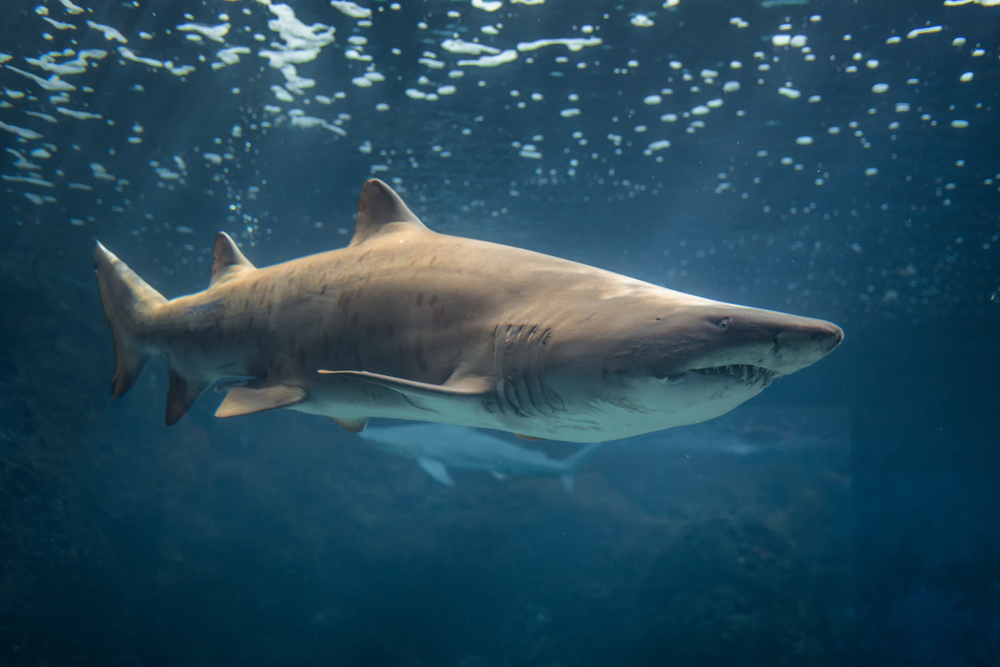
This aptly named shark is an aggressive and unpredictable fish that can be quite the handful for anglers. Not only are they fiercely territorial, they prefer to swim close to shore, and since they can survive in freshwater, they are often considered the most dangerous species of shark towards humans.
Appearance
A rather stocky shape – they are wider than other sharks its length – and has a blunt, flat snout. They are gray in color along the top, and have a whitish underbelly.
Maximum Size
11 feet and 700 pounds.
Geographic Range
They are found in warmer water across the globe, preferring coastal waters.
Habitat
Usually doesn’t swim deeper than 100 feet. Bull sharks have been known to swim up river streams as they can survive in freshwater, swimming as far as Illinois in one documented occasion.
Food
Mostly bony fishes and sharks, as well as turtles, birds, dolphins, and crustaceans.
Bull Shark Fishing Tips
Chumming and drift fishing are both effective tactics.
World Record
697 lb 12 oz (Malindi , Kenya, 2001)
Blacktip Shark
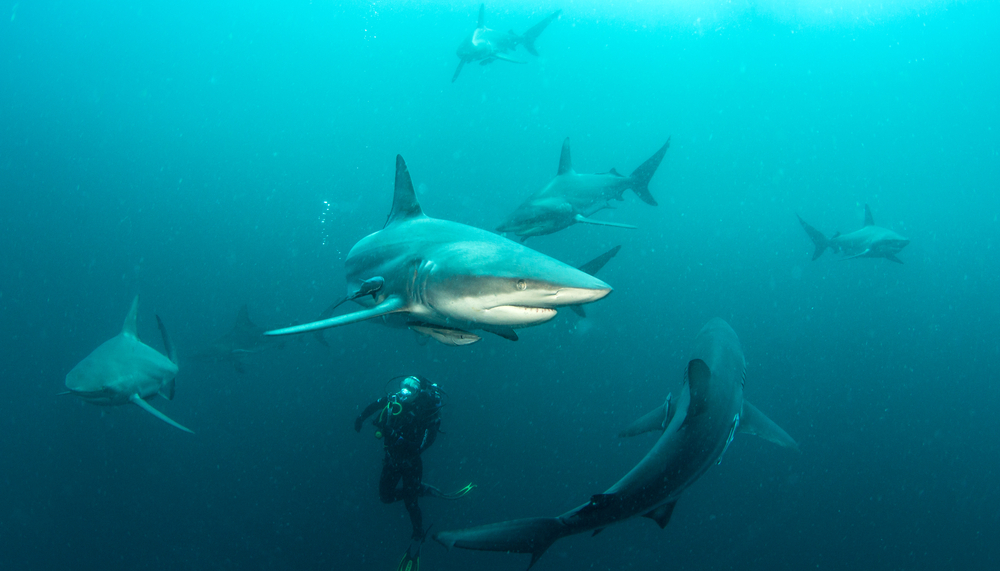
Blacktip sharks do not nearly grow as heavy as other species of sharks, but they certainly put up a terrific weight, much stronger than their weight would indicate. They are a popular target for anglers in the Caribbean, Gulf of Mexico, and South Africa.
Appearance
They are dark gray, ashy blue or dusky bronze in color on the back, with a yellowish-white belly. Its primary visual characteristic are persistent black spots on the tips of the pelvic fins, and relatively smaller eyes than most other sharks.
Maximum Size
9 feet long and 270 pounds.
Geographic Range
Now here’s a shark that gets around. Blacktip sharks are found all around the world: inshore, offshore, temperate water, tropical water, coral reef drop offs, muddy river mouths…it doesn’t seem to matter, blacktips find a way to survive.
Habitat
Prefer swimming inshore in waters less than 100 feet deep. Lagoons, drop-offs near coral reefs, mangrove swamps, and estuaries are some of the prime locations for blacktips.
Food
Fish makes up a majority of their diet, with the Gulf menhaden and Atlantic croaker being the most important prey for blacktips in the Gulf of Mexico.
Blacktip Shark Fishing Tips
Blacktips are normally considered a timid shark, but when food is present, they go wild. Blacktips will feast on any kind of bait, making them a favorite among anglers. Live bait, dead, bait, lures, and even flies will work with these eating machines.
World Record
270 lb 9 oz (Malindi Bay, Kenya, 1984)
Great White Shark
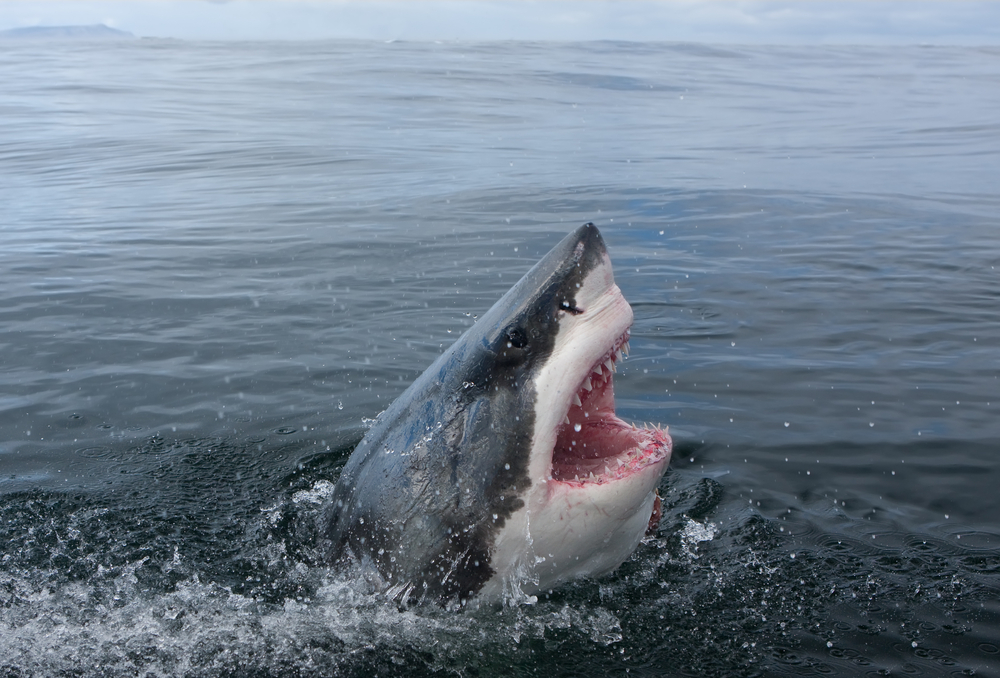
While the famed great white shark is a species that thrill-seeking anglers target, its protected status around the world means that utmost care must be taken when handling, and it must be released alive.
Terry Goss/Wikipedia Commons
Forget Richard Dreyfuss and Roy Scheider, the real star of Jaws was the great white shark itself. Great whites were never a common query for anglers until the blockbuster film, where fishing ballooned in popularity for thrill-seekers looking to catch a giant “man-eater” of their own. Sadly, the pursuit has led to population drops and it is now considered a protected species throughout much of the world. It is still legal to fish for, though it has to be released alive – NO harvesting whatsoever.
Appearance
These sharks get their name for their white underbelly. Along the sides and back, colors range from shades of brown to gray to blue.
Maximum Size
The largest of all predatory sharks, the great white shark weighs 2000 pounds on average, though females can reach over 4000 pounds.
Geographic Range
Great Whites live in almost all coastal and offshore waters between 54 and 75 °F. Some of the largest populations are in the Atlantic Northeast, California, Australia, Mediterranean, Japan, and the most densest of all, South Africa.
Habitat
Though the popular thought is that they are primarily a coastal fish, great white sharks thrive in offshore waters as well, reported at depths of 3000 feet.
Food
Tuna, rays, other sharks, dolphins, seals, whales, and sea turtles.
Great White Shark Fishing Tips
Bait fishing with large fish chunks (tuna especially) while chumming works best, but trolling can work as well.
World Record
2664 lb 0 oz (Ceduna, Sout, Australia, 1959)
Why Fish for Sharks?
No fish in the ocean – or creature on Earth, for that matter – has such a fearful reputation as the shark. While it is unfair to label them as the monsters championed by the Jaws movie franchise, there’s no denying that these fish are a heck of a fight for any angler, and requires careful handling or else risk a harmful bite. While it may be thrilling watching a marlin skip across the water, or trying to outmuscle a giant goliath grouper, there’s just something special about seeing the black eyes and teeth from a shark as it breaks the surface for the first time. Depending on where you fish, the chance to reel in a “monster” shark over 1000 pounds is a very real possibility.
Even the pursuit of shark can be a treat. From surf fishing at your local beach (it’ll make you think twice about swimming there again!), to chumming the water and waiting to see the iconic pointed dorsal fin poke out of the water, the anticipation can be just as rewarding as the catch itself.
Shark Fishing Methods
Chumming
Possibly the most used method for catching shark, chumming takes advantage of a shark’s obsession with food and its unmatched sense for finding it. Basically, to chum you take a pile of dead fish, chuck it out in the ocean, set your bait on a float or with a weight at a controlled depth in that chum, and drift fish until sharks come by. Two popular bait for chum are menhaden and mackerel, both of which can be bought in chum packages from local tackle and gear stores. Many stores offer them in custom-made dispensers that let out a bit at a time, but they also come in tin cans, where all you have to do is poke a couple holes into it before deployment. As for the bait on your line, use mullet, bluefish, mackerel, jackfish, or tuna. Keep an eye out for surfacing sharks, and don’t be surprised if a mako or other aggressive shark takes a bite at your chum bag instead of the bait on your line.
Trolling
Chumming works great for most species of sharks, but for others you need to troll. This technique is more commonly used on the west coast of North America, but it has found its place for anglers in the Atlantic as well. Trolling is most effective under the following scenarios:
- Fishing for thresher sharks.
- When in calm waters and drifting is not an option. Chum is more effective when there’s a trail to follow, rather than all that fish waste being bunched in one spot.
- When time is a factor. You’ll cover more water trolling.
- Fishing in currents, over and around wrecks and banks.
Tuna, mackerel, and squid are the most common bait for trolling.
An angler fishes the surf.
Kayak Fishing
Not for the faint of heart, kayak fishing for sharks is a great technique for those who are fine with the idea of handling a shark by hand without the safety barrier of a boat. This method takes a team of anglers ready to pin down a catch once it reaches shore to ensure no one gets hurt unhooking it. It also takes one brave kayaker. To kayak fish for sharks successfully,you must get your bait out into the water, often hundreds of yards out. To do that, have one angler hold the rod (or fit it securely on shore) while the kayaker paddles out with the end of the line up to 100-500 yards out, however far it takes until you’re fishing in at least 10 feet of water. Drop the bait – be sure it is weighted – and paddle back in. Once the weight is set, tighten up the slack and prepare for a strike. Sharks can bite hard and fast, so always be prepared for a fight right away.
Tip: When unhooking a shark, turn the fish upside down. Sharks essentially become paralyzed when directly on their backs, meaning you’ll have no fear of getting bit. But just to be safe, use needle-nosed pliers to keep your hands away from its teeth.
Shark Fishing Hotspots
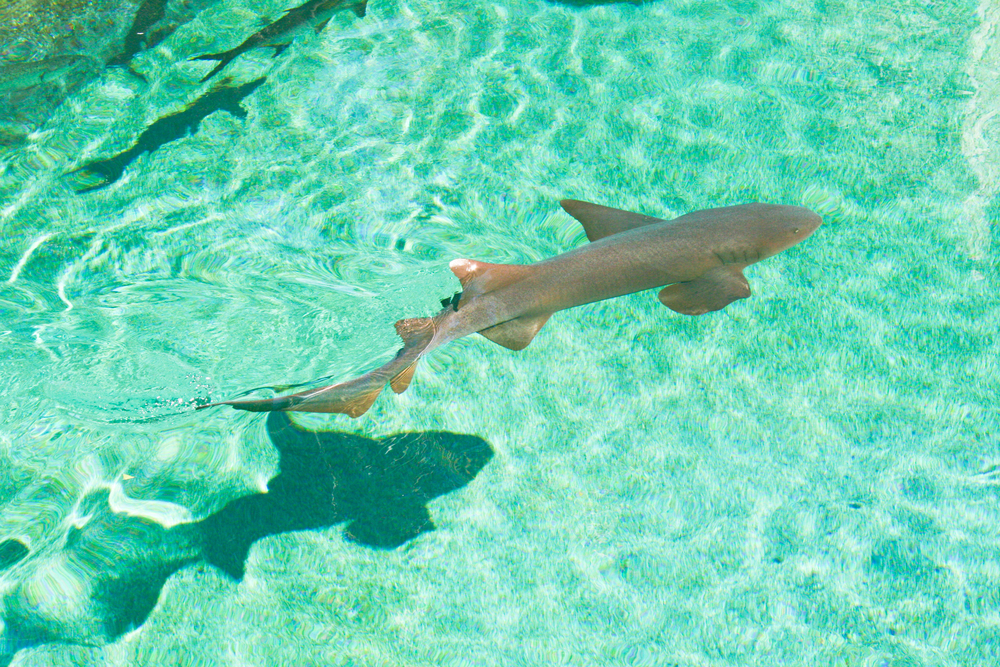
Sharks can be found all across the globe, swimming in depths of a few feet to nearly 7,000. But what locations should anglers target? Below are a few of the top spots for shark fishing, based on abundance, accessibility, and quality of game species.
Cape Cod, Massachusetts
Cape Cod has one of the highest populations of shortfin mako sharks in the world, and since many anglers consider this species to be the best shark to fish for, Cape Cod’s really where you got to be. The summer and early fall are the best times to go for makos. In addition, thresher sharks are aplenty off the coast of Massachusetts.
Bull Shark
NOAA
Padre Island National Seashore, Texas
You can catch shark from anywhere off the coast of Texas, but the Padre Island National Seashore (PINS) is largely considered to be the best spot. Hammerheads, bulls, blacktips, sand tigers, even the rare mako shark can be caught near this island system. It is also home to the state’s largest shark fishing tournaments. South Padre Island in particular is a popular destination.
Daytona Beach, Florida
In reality, the entire state of Florida is a shark fishing wonderland. The Florida Keys, for example, offer some of the best hammerhead shark fishing in the world, but Central Florida is the place to be, especially for those who love to surf fish or fish off a pier. Daytona Beach, as well as Ormond Beach to the north and New Smyrna Beach to the south, is packed full with all kind of sharks. Blacktip and bull sharks are the primary targets here, with summertime being the best time to go.
A blue shark caught by an angler.
Southeast Queensland, Australia
Australia is practically surrounded by sharks, but southeast Queensland offers the best variety. Dozens of sharks are available to catch, like bulls, blacktips, blues, threshers, and tiger sharks. The area around Brisbane, the Sunshine and Gold Coast in particular, is especially productive. Not all species are available for harvest, however (like the great white shark) so be wary about local regulations. Given the population density along the Australian coast, offshore shark fishing is the most popular method.






